Global Biobanks Market: By Product & Service, By Sample Type, By Storage Type, By Ownership, By Application, By End-User, By Region & Segmental Insights Trends and Forecast, 2024 – 2034
- Industry: Healthcare
- Report ID: TNR-110-1098
- Number of Pages: 420
- Table/Charts : Yes
- May, 2024
- Base Year : 2024
- No. of Companies : 10+
- No. of Countries : 29
- Views : 10152
- Covid Impact Covered: Yes
- War Impact Covered: Yes
- Formats : PDF, Excel, PPT
Biobanks are specialized facilities that store and manage biological samples, such as tissues, blood, cells, DNA, and other bodily fluids, along with associated clinical and demographic data. These repositories play a crucial role in biomedical research, translational medicine, and personalized healthcare by providing researchers, clinicians, and pharmaceutical companies with access to high-quality biospecimens for various applications.
Biobanks support basic, translational, and clinical research by providing researchers with access to well-characterized biospecimens and associated data. These resources facilitate studies aimed at understanding the molecular mechanisms of diseases, identifying biomarkers for early detection and diagnosis, elucidating disease progression, and developing new therapeutic interventions. Biobanks contribute to the drug discovery and development process by supplying researchers and pharmaceutical companies with the biological materials needed to identify and validate potential drug targets, evaluate drug efficacy and safety, conduct preclinical and clinical trials, and assess drug responses in patient populations. In terms of revenue, the global biobanks market was worth US$ 81.22 Bn in 2023, anticipated to witness CAGR of 11.1% During 2024 – 2034.
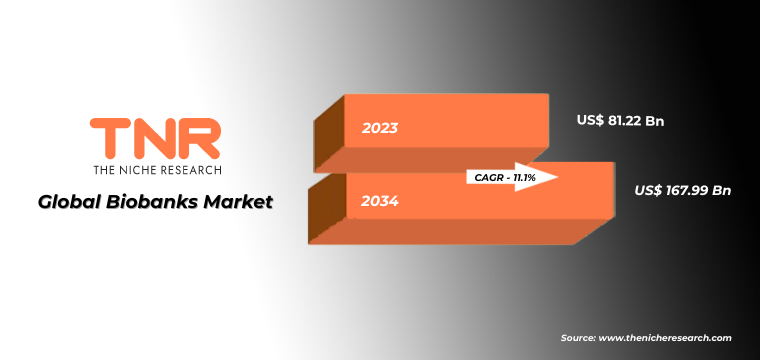
Global Biobanks Market Dynamics
Increasing Demand for Personalized Medicine: The growing emphasis on personalized medicine and precision healthcare has fuelled the demand for high-quality biospecimens and associated clinical data for research and therapeutic development. Biobanks play a crucial role in collecting, storing, and distributing biological samples and related information to support translational research, biomarker discovery, and drug development efforts aimed at delivering targeted therapies and interventions tailored to individual patient profiles.
Rapid Advancements in Biomedical Research: Technological advancements in genomics, proteomics, and other omics disciplines have accelerated biomedical research initiatives focused on understanding the molecular basis of diseases and identifying potential therapeutic targets. Biobanks serve as valuable repositories of well-characterized biospecimens and longitudinal health data, enabling researchers to conduct large-scale epidemiological studies, genome-wide association studies (GWAS), and multi-omics analyses to elucidate disease mechanisms, identify biomarkers, and develop novel diagnostic tools and treatments.
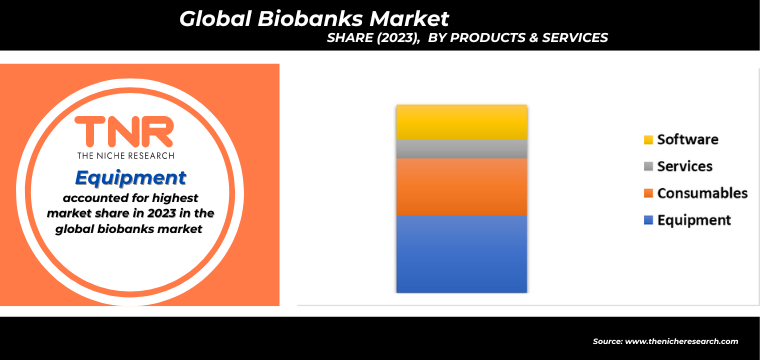
Equipment has Gained Popularity in the Recent Years and Has garnered major market share in the Global Biobanks Market During the Forecast Period (2024 – 2034).
Biobanks require specialized equipment for sample processing tasks such as centrifugation, aliquoting, Labeling, and preservation. High-throughput automated systems and robotic platforms enhance the efficiency and accuracy of sample handling procedures, allowing biobanks to process large volumes of samples quickly and consistently. Demand for equipment that enables streamlined sample processing workflows is driven by the need to optimize resource utilization, minimize manual errors, and accelerate sample turnaround times.
Proper storage conditions are critical for maintaining sample integrity and stability over time. Biobanks invest in equipment such as ultra-low temperature freezers, cryogenic storage systems, and automated sample retrieval systems to ensure optimal storage conditions for various sample types, including tissues, blood, cells, and DNA. Demand for reliable and energy-efficient storage solutions is driven by the need to preserve sample quality, minimize sample degradation, and comply with regulatory requirements governing sample storage and tracking.
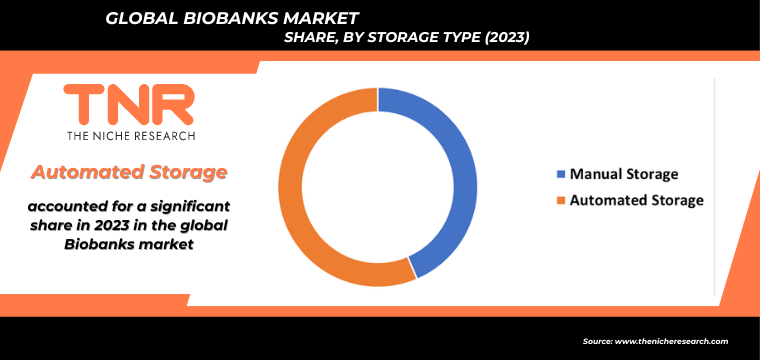
By Sample Type Blood Products Segment had the Highest Share in the Global Biobanks Market in 2023.
The Blood Product segment dominated the global Biobanks market, in terms of revenue and is estimated to sustain its dominance over the forecast period. Blood products obtained from biobanks are essential for various clinical applications, including transfusions for patients undergoing surgeries, cancer treatments, organ transplants, and management of blood disorders such as anaemia and haemophilia. The availability of a diverse range of blood products ensures that healthcare providers can meet the needs of patients with different medical conditions.
Biobanks serve as valuable resources for biomedical research aimed at understanding the physiology of blood, identifying disease biomarkers, developing new diagnostic tests, and discovering novel therapies. Blood samples stored in biobanks are used in studies investigating the genetic basis of diseases, pharmacogenomics, and population health research, among other areas. The demand for blood products from biobanks is driven by the need for high-quality samples to support research initiatives.
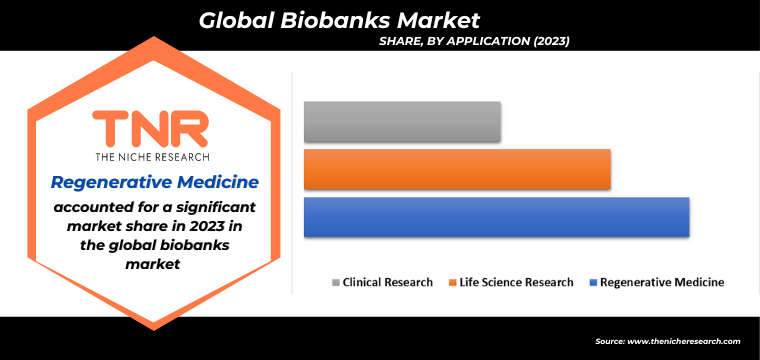
By End User Pharmaceutical & Biotechnology Companies and CROs has the Highest Share in the Global Biobanks Market in 2023.
Pharmaceutical and biotechnology companies conduct extensive research and development (R&D) activities to discover and develop new drugs, therapies, and medical products. Biobanks provide these companies with access to high-quality human biological samples, including tissues, blood, cells, and DNA, which are essential for conducting preclinical studies, biomarker discovery, target validation, and clinical trials. The availability of well-characterized and ethically sourced samples from diverse populations is crucial for accelerating the drug development process.
With the rise of precision medicine approaches, pharmaceutical and biotechnology companies are increasingly focusing on developing targeted therapies and personalized treatments tailored to individual patients. Biobanks play a critical role in supporting precision medicine initiatives by providing access to longitudinal patient samples, clinical data, and genetic information. By analyzing these resources, companies can identify genetic markers, biomarkers, and therapeutic targets associated with specific diseases or patient subpopulations, leading to the development of more effective and personalized treatments.
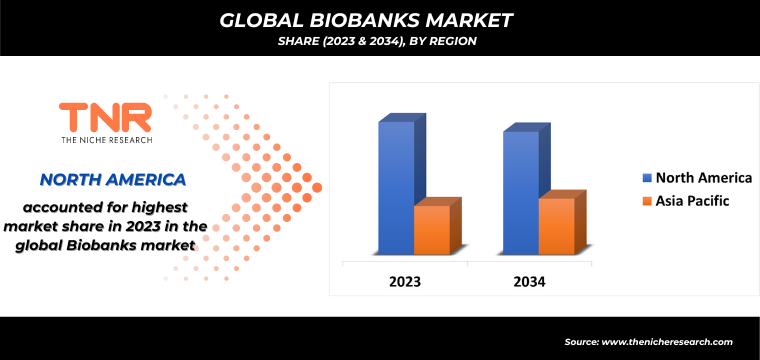
North America has garnered major market share in 2023 accounting for ~43.5% in the global biobanks market.
North America is home to numerous pharmaceutical, biotechnology, and research institutions that are actively engaged in drug discovery, development, and clinical research. Biobanks play a crucial role in supporting these efforts by providing researchers with access to high-quality biological samples, such as tissue, blood, and DNA, along with associated clinical and demographic data. The adoption of precision medicine approaches, which aim to tailor medical treatments to individual patients based on their genetic makeup, is driving the demand for biobanks in North America.
Biobanks serve as repositories of diverse biological samples and molecular data, enabling researchers and clinicians to study the genetic basis of diseases, identify biomarkers, and develop personalized therapies. The rapid advancements in genomics, proteomics, and other omics technologies have generated vast amounts of biological data that require comprehensive storage and management solutions. Biobanks provide a centralized platform for storing, cataloging, and sharing biological samples and associated data, facilitating collaborative research and data-driven discoveries.
Competitive Landscape: Global Biobanks Market:
- Avantor Inc.
- Azenta Inc
- Becton Dickinson and Company
- Cryoport Inc.
- Hamilton Company
- Merck & Co., Inc.
- PHC Holdings Corporation
- Qiagen N.V.
- Tecan Trading AG
- Thermo Fisher Scientific, Inc.
- Other Industry Participants
Global Biobanks Market: Key Takeaway
| Report Specifications | Details |
| Market Revenue in 2023 | US$ 81.22 Bn |
| Market Size Forecast by 2034 | US$ 167.99 Bn |
| Growth Rate (CAGR) | 11.1% |
| Historic Data | 2016 – 2022 |
| Base Year for Estimation | 2023 |
| Forecast Period | 2024 – 2034 |
| Report Inclusions | Market Size & Estimates, Market Dynamics, Competitive Scenario, Trends, Growth Factors, Market Determinants, Key Investment Segmentation, Product/Service/Solutions Benchmarking |
| Segments Covered | By Product & Service, By Sample Type, By Storage Type, By Ownership, By Application, By End-User |
| Regions Covered | North America, Europe, Asia Pacific, Middle East & Africa, Latin America |
| Countries Covered | U.S., Canada, Mexico, Rest of North America, France, The UK, Spain, Germany, Italy, Nordic Countries (Denmark, Finland, Iceland, Sweden, Norway), Benelux Union (Belgium, The Netherlands, Luxembourg), Rest of Europe, China, Japan, India, New Zealand, Australia, South Korea, Southeast Asia (Indonesia, Thailand, Malaysia, Singapore, Rest of Southeast Asia), Rest of Asia Pacific, Saudi Arabia, UAE, Egypt, Kuwait, South Africa, Rest of Middle East & Africa, Brazil, Argentina, Rest of Latin America |
| Key Players | Avantor Inc, Azenta Inc, Becton Dickinson and Company, Cryoport Inc., Hamilton Company, Merck & Co., Inc., PHC Holdings Corporation, Qiagen N.V., Tecan Trading AG, Thermo Fisher Scientific, Inc., Other Industry Participants |
| Customization Scope | Customization allows for the inclusion/modification of content pertaining to geographical regions, countries, and specific market segments. |
| Pricing & Procurement Options | Explore purchase options tailored to your specific research requirements |
| Contact Details | Consult With Our Expert
Japan (Toll-Free): +81 663-386-8111 South Korea (Toll-Free): +82-808- 703-126 Saudi Arabia (Toll-Free): +966 800-850-1643 United Kingdom: +44 753-710-5080 United States: +1 302-232-5106 E-mail: askanexpert@thenicheresearch.com |
Global Biobanks Market
By Product & Service
- Equipment
- Storage Equipment
- Sample Analysis Equipment
- Sample Processing Equipment
- Sample Transport Equipment
- Consumables
- Storage Consumables
- Analysis Consumables
- Processing Consumables
- Collection Consumables
- Services
- Storage Services
- Processing Services
- Transport Services
- Supply Services
- Software
By Sample Type
- Blood Products
- Human Tissues
- Cell Lines
- Nucleic Acids
- Biological Fluids
- Human Waste product
By Storage Type
- Manual Storage
- Automated Storage
By Ownership
- Universities
- National/ Regional agencies
- Non-Profit Organization
- Private organization
By Application
- Regenerative Medicine
- Life Science Research
- Clinical Research
By End-User
- Pharmaceutical & Biotechnology Companies and CROs
- Academic & Research Institutes
- Hospitals
By Region
- North America (U.S., Canada, Mexico, Rest of North America)
- Europe (France, The UK, Spain, Germany, Italy, Nordic Countries (Denmark, Finland, Iceland, Sweden, Norway), Benelux Union (Belgium, The Netherlands, Luxembourg), Rest of Europe
- Asia Pacific (China, Japan, India, New Zealand, Australia, South Korea, Southeast Asia (Indonesia, Thailand, Malaysia, Singapore, Rest of Southeast Asia), Rest of Asia Pacific
- Middle East & Africa (Saudi Arabia, UAE, Egypt, Kuwait, South Africa, Rest of Middle East & Africa)
- Latin America (Brazil, Argentina, Rest of Latin America)
Report Layout:
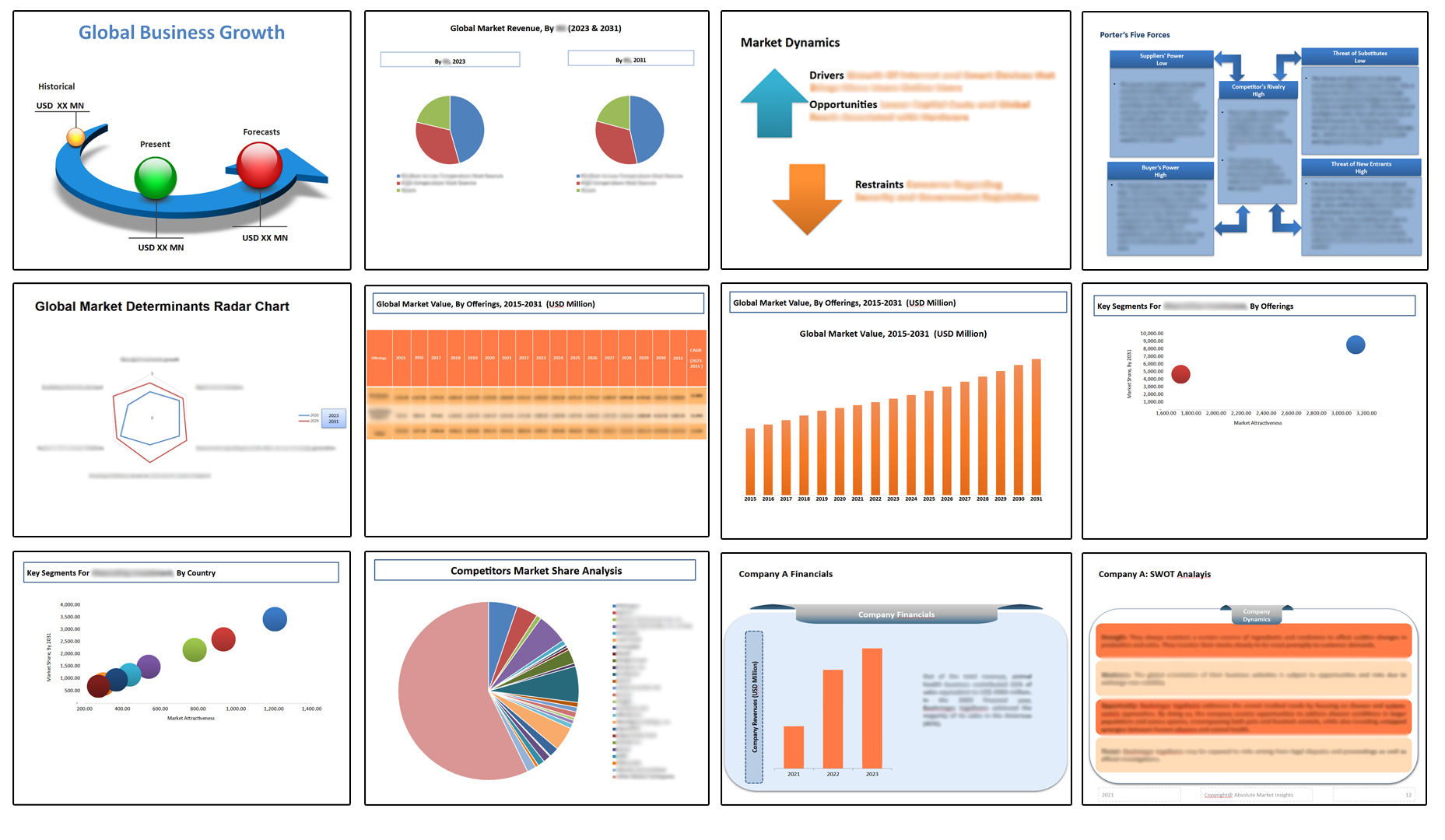
Table of Contents
**Exclusive for Multi-User and Enterprise User.
Global Biobanks Market
By Product & Service
- Equipment
- Storage Equipment
- Sample Analysis Equipment
- Sample Processing Equipment
- Sample Transport Equipment
- Consumables
- Storage Consumables
- Analysis Consumables
- Processing Consumables
- Collection Consumables
- Services
- Storage Services
- Processing Services
- Transport Services
- Supply Services
- Software
By Sample Type
- Blood Products
- Human Tissues
- Cell Lines
- Nucleic Acids
- Biological Fluids
- Human Waste product
By Storage Type
- Manual Storage
- Automated Storage
By Ownership
- Universities
- National/ Regional agencies
- Non-Profit Organization
- Private organization
By Application
- Regenerative Medicine
- Life Science Research
- Clinical Research
By End-User
- Pharmaceutical & Biotechnology Companies and CROs
- Academic & Research Institutes
- Hospitals
By Region
- North America (U.S., Canada, Mexico, Rest of North America)
- Europe (France, The UK, Spain, Germany, Italy, Nordic Countries (Denmark, Finland, Iceland, Sweden, Norway), Benelux Union (Belgium, The Netherlands, Luxembourg), Rest of Europe
- Asia Pacific (China, Japan, India, New Zealand, Australia, South Korea, Southeast Asia (Indonesia, Thailand, Malaysia, Singapore, Rest of Southeast Asia), Rest of Asia Pacific
- Middle East & Africa (Saudi Arabia, UAE, Egypt, Kuwait, South Africa, Rest of Middle East & Africa)
- Latin America (Brazil, Argentina, Rest of Latin America)
The Niche Research approach encompasses both primary and secondary research methods to provide comprehensive insights. While primary research is the cornerstone of our studies, we also incorporate secondary research sources such as company annual reports, premium industry databases, press releases, industry journals, and white papers.
Within our primary research, we actively engage with various industry stakeholders, conducting paid interviews and surveys. Our meticulous analysis extends to every market participant in major countries, allowing us to thoroughly examine their portfolios, calculate market shares, and segment revenues.
Our data collection primarily focuses on individual countries within our research scope, enabling us to estimate regional market sizes. Typically, we employ a bottom-up approach, meticulously tracking trends in different countries. We analyze growth drivers, constraints, technological innovations, and opportunities for each country, ultimately arriving at regional figures.Our process begins by examining the growth prospects of each country. Building upon these insights, we project growth and trends for the entire region. Finally, we utilize our proprietary model to refine estimations and forecasts.
Our data validation standards are integral to ensuring the reliability and accuracy of our research findings. Here’s a breakdown of our data validation processes and the stakeholders we engage with during our primary research:
- Supply Side Analysis: We initiate a supply side analysis by directly contacting market participants, through telephonic interviews and questionnaires containing both open-ended and close-ended questions. We gather information on their portfolios, segment revenues, developments, and growth strategies.
- Demand Side Analysis: To gain insights into adoption trends and consumer preferences, we reach out to target customers and users (non-vendors). This information forms a vital part of the qualitative analysis section of our reports, covering market dynamics, adoption trends, consumer behavior, spending patterns, and other related aspects.
- Consultant Insights: We tap into the expertise of our partner consultants from around the world to obtain their unique viewpoints and perspectives. Their insights contribute to a well-rounded understanding of the markets under investigation.
- In-House Validation: To ensure data accuracy and reliability, we conduct cross-validation of data points and information through our in-house team of consultants and utilize advanced data modeling tools for thorough verification.
The forecasts we provide are based on a comprehensive assessment of various factors, including:
- Market Trends and Past Performance (Last Five Years): We accurately analyze market trends and performance data from preceding five years to identify historical patterns and understand the market’s evolution.
- Historical Performance and Growth of Market Participants: We assess the historical performance and growth trajectories of key market participants. This analysis provides insights into the competitive landscape and individual company strategies.
- Market Determinants Impact Analysis (Next Eight Years): We conduct a rigorous analysis of the factors that are projected to influence the market over the next eight years. This includes assessing both internal and external determinants that can shape market dynamics.
- Drivers and Challenges for the Forecast Period:Identify the factors expected to drive market growth during the forecast period, as well as the challenges that the industry may face. This analysis aids in deriving an accurate growth rate projection.
- New Acquisitions, Collaborations, or Partnerships: We keep a close watch on any new acquisitions, collaborations, or partnerships within the industry. These developments can have a significant impact on market dynamics and competitiveness.
- Macro and Micro Factors Analysis:A thorough examination of both macro-level factors (e.g., economic trends, regulatory changes) and micro-level factors (e.g., technological advancements, consumer preferences) that may influence the market during the forecast period.
- End-User Sentiment Analysis: To understand the market from the end-user perspective, we conduct sentiment analysis. This involves assessing the sentiment, preferences, and feedback of the end-users, which can provide valuable insights into market trends.
- Perspective of Primary Participants: Insights gathered directly from primary research participants play a crucial role in shaping our forecasts. Their perspectives and experiences provide valuable qualitative data.
- Year-on-Year Growth Trend: We utilize a year-on-year growth trend based on historical market growth and expected future trends. This helps in formulating our growth projections, aligning them with the market’s historical performance.
Research process adopted by TNR involves multiple stages, including data collection, validation, quality checks, and presentation. It’s crucial that the data and information we provide add value to your existing market understanding and expertise. We have also established partnerships with business consulting, research, and survey organizations across regions and globally to collaborate on regional analysis and data validation, ensuring the highest level of accuracy and reliability in our reports.









